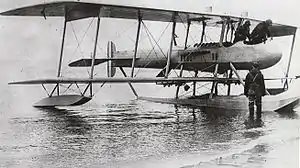Gallaudet D-4
The Gallaudet D-4 was an unusual biplane designed and built by Gallaudet Aircraft Company for the United States Navy. It was powered by a Liberty L-12 engine buried within the fuselage which turned a large, four-bladed propeller attached to a ring around the center fuselage. Only two were constructed, with the second being accepted by the Navy for service as an observation aircraft.[1]
| Gallaudet D-4 | |
|---|---|
 | |
| Role | Navy Observation Aircraft |
| Manufacturer | Gallaudet Aircraft Company |
| First flight | 1918 |
| Introduction | 1918 |
| Primary user | United States Navy |
| Produced | 2 |
| Number built | 2 |
Development
In response to a requirement by the U.S. Navy for light floatplanes capable of being launched off catapults by ships underway, the Gallaudet Aircraft company began development of the "D-4", based on the earlier Gallaudet D-1. The D-1 was powered by two Duesenberg engines of 150 hp (110 kW) each and used a clutch mechanism to allow the use of one or both engines.[2] The D-1 made its first flight on 17 July 1916 and despite numerous mechanical difficulties the Army bought four of the improved D-2 versions.
In an effort to produce an aircraft with the best possible forward visibility for the observer, Gallaudet developed the D-2 into the unconventional D-4, which placed the observer in the nose, followed by the pilot, with the propeller attached to a ring that circled the fuselage behind the wings. The four blades spun around the fuselage just behind the pilot.
Power for the D-4 was supplied by a 360 hp (270 kW) Liberty engine buried within the fuselage just behind the pilot. A large pontoon was mounted below the fuselage, and small outboard floats were mounted near the tips of the swept-back wings.
Operational history
Two D-4s were built, serial numbers A:2653 and A:2654. The prototype crashed as result of a failed elevator control during flight testing on 19 July 1918, killing the pilot, Lt. Arthur Souther. The second D4 first flew in October 1918 and was accepted by the U.S. Navy in April 1919. This aircraft was entered in the Curtiss Marine Trophy Race during the National Air Races in Detroit Michigan on October 8, 1922, but had to leave the race after the fifth lap because of a broken propeller.[3] No further aircraft were built, as Gallaudet turned their attention to constructing Curtiss HS-2L flying boats.
.jpg.webp)
Specifications
Data from American Combat Planes p. 118 [1]
General characteristics
- Crew: two (pilot, observer)
- Length: 33 ft 6 in (10.2 m)
- Wingspan: 46 ft 5 in (14.1 m)
- Height: 11 ft 8 in (3.6 m)
- Wing area: 612 sq ft (56.9 m2)
- Empty weight: 4,228 lb (1,918 kg)
- Gross weight: 5,440 lb (2,468 kg)
- Powerplant: 1 × Liberty L-12 V-12 water-cooled piston engine , 360 hp (269 kW)
Performance
- Maximum speed: 119 mph (192 km/h, 103 kn) landing speed 58 mph
- Range: 390 mi (628 km, 340 nmi)
- Endurance: 3 hours 30 minutes
- Service ceiling: 14,000 ft (4,267 m)
Armament
- None
See also
Related development
- Gallaudet D-1
- Gallaudet D-2
Aircraft of comparable role, configuration, and era
References
- Wagner, Ray (1982). American Combat Planes, Third Edition. USA: Doubleday & Company. ISBN 0-385-13120-8.
- "Gallaudet D-1 / D-4". flyingmachines.ru. Retrieved 31 October 2015.
- Robert Gordon. "GALLAUDET D-1". earlyaviators.com. Archived from the original on 7 February 2007. Retrieved 31 October 2015.
Bibliography
External links
- Photos of D-4 at airminded.net. Accessed 2011-09-30.
- Photo of D-4 at earlyaviators.com. Accessed 2011-09-30.